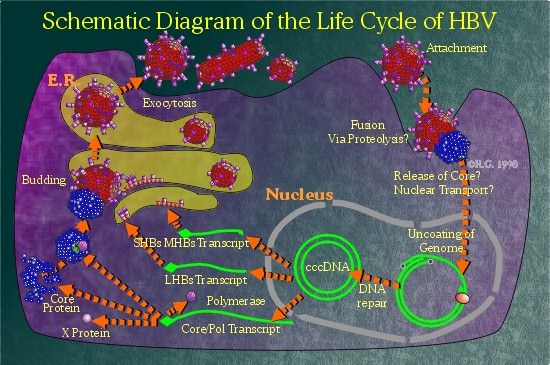Replication
- HBV's unique mode of replication takes place in the nucleus of the infected
host cell. Entrance into the cell takes place via receptor-mediated endocytosis as the
envelope is shed and the viral core particle with the DNA viral genome is translocated
into the nucleus of the host cell. The viral DNA is then repaired and transformed into
closed cirucular DNA (cccDNA)by endogenous viral reverse transcriptase. Analogous to the
DNA of retrovirus, HBV differs in that its cccDNA does not integrate and stays episomal.
- A diagramatic representation of HBV's replication process. DR1 and DR2 depict direct
repeat sequences, consisting of 12 bp each.
-
- RNA polymerase II then uses the cccDNA as a template to make
greater-than-full length viral mRNA. Because the mRNA is longer than the cccDNA, repeated
terminal ends are formed. Once formed, this "pregenome" (+) RNA exits the
nucleus and is then translated to produce the core antigens and HBV polymerase it needs to
encapsidate itself. The (-) DNA is then transcribed inside the capsid by reverse
transcriptase. RNaseH then chews the (+)RNA away , leaving a small stretch of RNA, an
undigested 5' oligoribonucleotide. This segment of RNA is comprised of a small sequence
including the DR1 region. The oligomer is then annealed to the DR2 portion of the DNA at
the 5' end. HBV polymerase then generates complementary (+)DNA using this oligomer as a
primer. A portion of these newly synthesized plus strands of DNA are then packaged into
virions with envelopes and the hepatitis B surface antigen (HBsAg) in the endoplasmic
reticulum. The rest of the strands are sent back to the nucleus to serve as templates.
It is thought that reverse transcription and DNA synthesis may take
place in completed core particles. If this is true, the variation in (+)DNA strand lengths
can be explained by the limited number of free nucleotides within each core particle.
Another possibility for varied lengths between 1700 and 2800 bps is that the virus may
exit the cell before alotting the DNA enough time to fully synthesize.
-
 For a
recap of all the important features of HBV DNA synthesis, click here!
For a
recap of all the important features of HBV DNA synthesis, click here!
![]()


![]() For a
recap of all the important features of HBV DNA synthesis, click here!
For a
recap of all the important features of HBV DNA synthesis, click here!